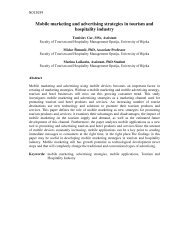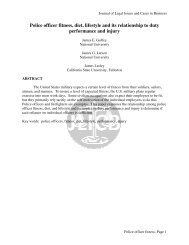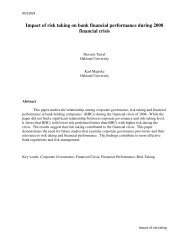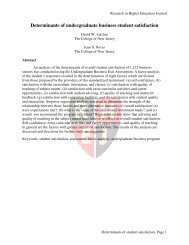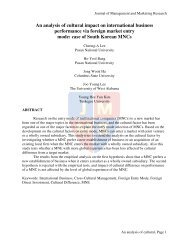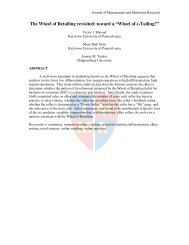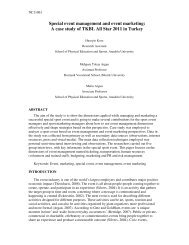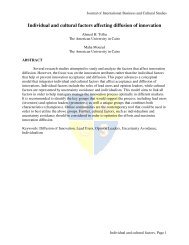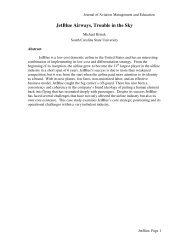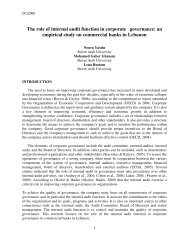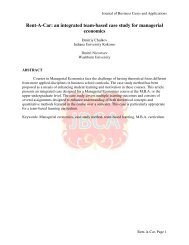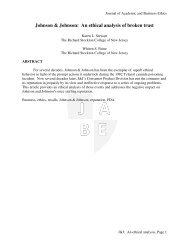Need-Based Segmentation Analysis of University Career Services ...
Need-Based Segmentation Analysis of University Career Services ...
Need-Based Segmentation Analysis of University Career Services ...
You also want an ePaper? Increase the reach of your titles
YUMPU automatically turns print PDFs into web optimized ePapers that Google loves.
Research In Higher Education Journal<br />
situation. Universities whose main objective is just to get more students more involved in career<br />
services would likely want to focus their efforts on unprepareds, best-fit techies and hightouches,<br />
because these are the segments most likely to yield them more “new and repeat<br />
business” for their services. On the other hand, schools who view their mission one <strong>of</strong> increasing<br />
the overall employability <strong>of</strong> all students may want to focus their efforts on reaching out to those<br />
students who may be less interested but likely most in need <strong>of</strong> job skills training (e.g.,<br />
placements).<br />
This research has identified and described four need-based segments <strong>of</strong> career services<br />
users and presented a set <strong>of</strong> customized marketing strategies designed to increase student<br />
participation within each segment. This research extends the literature on career services usage<br />
and may serve to improve the effectiveness <strong>of</strong> career services practice. By providing a better<br />
understanding <strong>of</strong> student needs, this research should allow colleges and universities to<br />
specifically target the groups identified in this study, increase their participation with career<br />
services, thereby, helping their graduates to develop the behaviors, techniques, and attitudes<br />
necessary to obtain employment.<br />
References<br />
Athavaley, Anjali (2007). A job interview you don’t have to show up for. Wall Street Journal,<br />
June 20 Front.<br />
Athavaley, Anjali (2006). Posting your résumé on YouTube. Wall Street Journal, December 6<br />
D1.<br />
Baker, Gregory A. (1998). The development <strong>of</strong> a mentor program to foster career management.<br />
International Food & Agribusiness Management Review, 1(2), 259-269.<br />
Bednowitz, Ian. (2000). The impact <strong>of</strong> the Business Week and U.S. News & World Report<br />
rankings on the business schools they rank. ERIC number ed481757.<br />
Behrens, Troy and Brian Altman (1998). Technology: Impact on and implications for college<br />
career centers. Journal <strong>of</strong> <strong>Career</strong> Planning & Employment, 58 (2) 19-24.<br />
Best, Roger (2005). Market-<strong>Based</strong> Management: Strategies for Growing Customer Value and<br />
Pr<strong>of</strong>itability. Upper Saddle River, New Jersey, Fourth Edition, Prentice Hall.<br />
Brooks, Jennifer E. (1996). Multifaceted relationships benefit career services <strong>of</strong>fices and<br />
employer recruiters. The Journal <strong>of</strong> <strong>Career</strong> Planning & Employment, 57 (1) 61-64.<br />
Brown, S.D., and N.E.R. Krane (2000). Four (or five) sessions and a cloud <strong>of</strong> dust: Old<br />
assumptions and new observations about career counseling. In S. Brown & R. Lent<br />
(Eds.), Handbook <strong>of</strong> Counseling Psychology, 3 RD ed., 740-766, NY: Wiley.<br />
Bullock Marcy, and Jennifer E. Brooks (1994). An essential job: Marketing the placement <strong>of</strong>fice<br />
to faculty and employers. Journal <strong>of</strong> <strong>Career</strong> Planning and Employment, 54 (2) 28-31.<br />
Casella, D.A. (1990). <strong>Career</strong> networking-the new career center paradigm. Journal <strong>of</strong> <strong>Career</strong><br />
Planning & Employment, 50 (4) 32-39.<br />
Chrzan K. & Golovashkina N. (2006). An empirical test <strong>of</strong> six stated importance measures.<br />
International Journal <strong>of</strong> Marketing Research, 48 (6).<br />
Cohen, S. (2003). Maximum difference scaling: improved measures <strong>of</strong> importance and<br />
preference for segmentation. Proceedings <strong>of</strong> the 2003 Sawtooth S<strong>of</strong>tware Conference,<br />
San Diego, CA, 61-74.<br />
Cohen, S. & Orme B. (2004). What's your preference? Marketing Research, 16 (Summer 2004),<br />
32-37.<br />
<strong>Need</strong>s-<strong>Based</strong> <strong>Segmentation</strong> <strong>Analysis</strong>, Page 17



